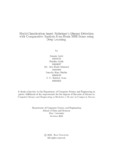| dc.contributor.advisor | Parvez, Mohammad Zavid | |
| dc.contributor.advisor | Hussain, Emtiaz | |
| dc.contributor.author | Kabir, Azmain | |
| dc.contributor.author | Kabir, Farishta | |
| dc.contributor.author | Mahmud, Md. Abu Hasib | |
| dc.contributor.author | Sinthia, Sanzida Alam | |
| dc.contributor.author | Azam, S. M. Rakibul | |
| dc.date.accessioned | 2022-04-19T05:34:13Z | |
| dc.date.available | 2022-04-19T05:34:13Z | |
| dc.date.copyright | 2021 | |
| dc.date.issued | 2021-10 | |
| dc.identifier.other | ID 18101576 | |
| dc.identifier.other | ID 18101697 | |
| dc.identifier.other | ID 18101189 | |
| dc.identifier.other | ID 18101219 | |
| dc.identifier.other | ID 18101123 | |
| dc.identifier.uri | http://hdl.handle.net/10361/16552 | |
| dc.description | This thesis is submitted in partial fulfillment of the requirements for the degree of Bachelor of Science in Computer Science and Engineering, 2021. | en_US |
| dc.description | Cataloged from PDF version of thesis. | |
| dc.description | Includes bibliographical references (pages 41-42). | |
| dc.description.abstract | The neurodegenerative Alzheimer's Disease is the most widely recognized cause of
`Dementia' and was allegedly the 7th highest cause of death globally. Nevertheless,
there is still no conclusive test for distinguishing Alzheimer's disease. Our proposed
model eliminates these challenges in an effective manner. The technique fits and
analyzes different classes in a single setting and requires signi ficantly less previ-
ous apprehension. Several handcrafted or prede ned machine learning and deep
learning models have been implemented in this fi eld of study. Our proposed multi-
classi cation model is primarily implemented based on the Open Access Series of
Imaging Studies (OASIS) data and suggests an 18-layer architecture. We have im-
plemented a unique preprocessing approach of all three anatomical planes of the
MRI scans in a single sequential model, which was also evaluated afterward. The
research also explores a comparative study among multiple and binary classes in
terms of performance and effciency. Prede ned models such as InceptionV3 and
VGG19 have also been brought to comparison to measure the model's reliability.
Our multiclass setting shows an accuracy of over 80%, which is higher than most
of the existing multi-classi fication models in this dataset. Moreover, the in-depth
comparative study using binary classi cation shows a signi ficant accuracy of over
92%, which ensures the overall efficacy of the model. | en_US |
| dc.description.statementofresponsibility | Azmain Kabir | |
| dc.description.statementofresponsibility | Farishta Kabir | |
| dc.description.statementofresponsibility | Md. Abu Hasib Mahmud | |
| dc.description.statementofresponsibility | Sanzida Alam Sinthia | |
| dc.description.statementofresponsibility | S. M. Rakibul Azam | |
| dc.format.extent | 42 pages | |
| dc.language.iso | en | en_US |
| dc.publisher | Brac University | en_US |
| dc.rights | Brac University theses are protected by copyright. They may be viewed from this source for any purpose, but reproduction or distribution in any format is prohibited without written permission. | |
| dc.subject | Alzheimer's disease | en_US |
| dc.subject | CNN | en_US |
| dc.subject | Multi-class | en_US |
| dc.subject | Binary class | en_US |
| dc.subject | MRI | en_US |
| dc.subject | Deep learning | en_US |
| dc.subject | Early detection | en_US |
| dc.subject | Comparative analysis | en_US |
| dc.subject | 18-layer | en_US |
| dc.subject | 3D Scans | en_US |
| dc.subject | OASIS-1 | en_US |
| dc.subject.lcsh | Artificial intelligence | |
| dc.subject.lcsh | Machine learning. | |
| dc.title | Multi-classification based Alzheimer's disease detection with comparative analysis from brain MRI scans using deep learning | en_US |
| dc.type | Thesis | en_US |
| dc.contributor.department | Department of Computer Science and Engineering, Brac University | |
| dc.description.degree | B. Computer Science | |

